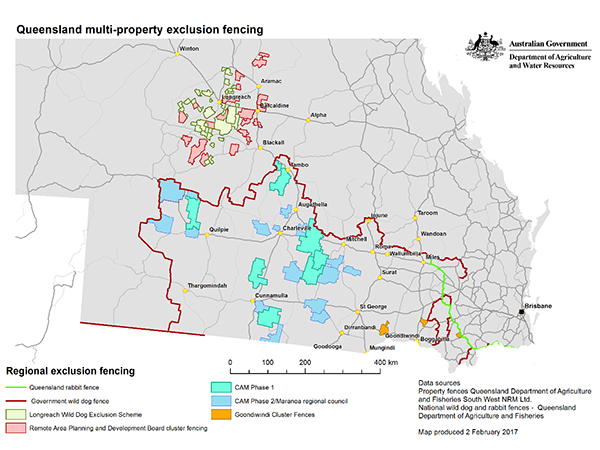Getting a lot of efficiency out of cluster fencing
Northwest of Quilpie in Queensland, in a corner of the Wild Dog Barrier Fence, eight graziers are achieving a lot with a little from their high integrity cluster fence.
The numbers are big. By erecting 107 km of fencing and utilising the existing Wild Dog Barrier Fence, they have enclosed 339,765 hectares over eight properties to help better manage the impacts of wild dogs. Likewise, southeast of Stonehenge in Queensland, 14 landholders have enclosed 14 properties with over 340 km of cluster fencing encompassing 188,200 hectares.

Multi-property exclusion fencing in Queensland.
Funding assistance from the Australian and Queensland governments has allowed many farming cluster groups to construct cluster fences throughout central and southwest Queensland.
But erecting a high integrity cluster fence is just the beginning, with cluster groups and the wider community experiencing the many benefits that come with the fences. The good news is that landholders within the cluster fences are seeing fewer wild dog attacks on their livestock.
Before the cluster fences, the impact from wild dogs was devastating, with graziers in the regions losing sheep and experiencing lambing rates of 30 per cent or less. Some graziers were considering getting out of sheep altogether.
Strikingly, within the first year of a cluster fence being completed, it was not unusual to see lambing rates bounce back to 80 per cent or more. Graziers are seeing their flocks improving too. Not only with increasing numbers, but their condition is improving because they are more relaxed and content. And the benefits keep piling up within the cluster fences.
Pastures are improving with a reduction in total grazing pressure from other animals leading to an increase in groundcover. Herbages and grasses are appearing that haven’t been seen before. Long-term carrying capacity is improving with farmers locking up and resting country.
More grass means farming businesses have become more resilient, particularly during prolonged dry conditions. On-farm biosecurity is enhanced as well, with landholders hoping to eradicate lice and brucellosis and limit the movement of weeds all thanks to the cluster fences.
The benefits are flowing off-farm with rural and regional communities excited about receiving a much needed boost where the fences have been constructed. Increasing sheep numbers will mean more work for more shearers for longer. Employment is rising for fencing contractors and local fencing suppliers have benefited from the increase in sales.
More importantly, the health and wellbeing of graziers and their families involved in cluster groups has improved. Graziers are gaining confidence and are now back in control. Their anxiety has been significantly reduced with their families noticing the change. Farming communities are now seeing the value in good fences and are moving forward focussing on what is important.



